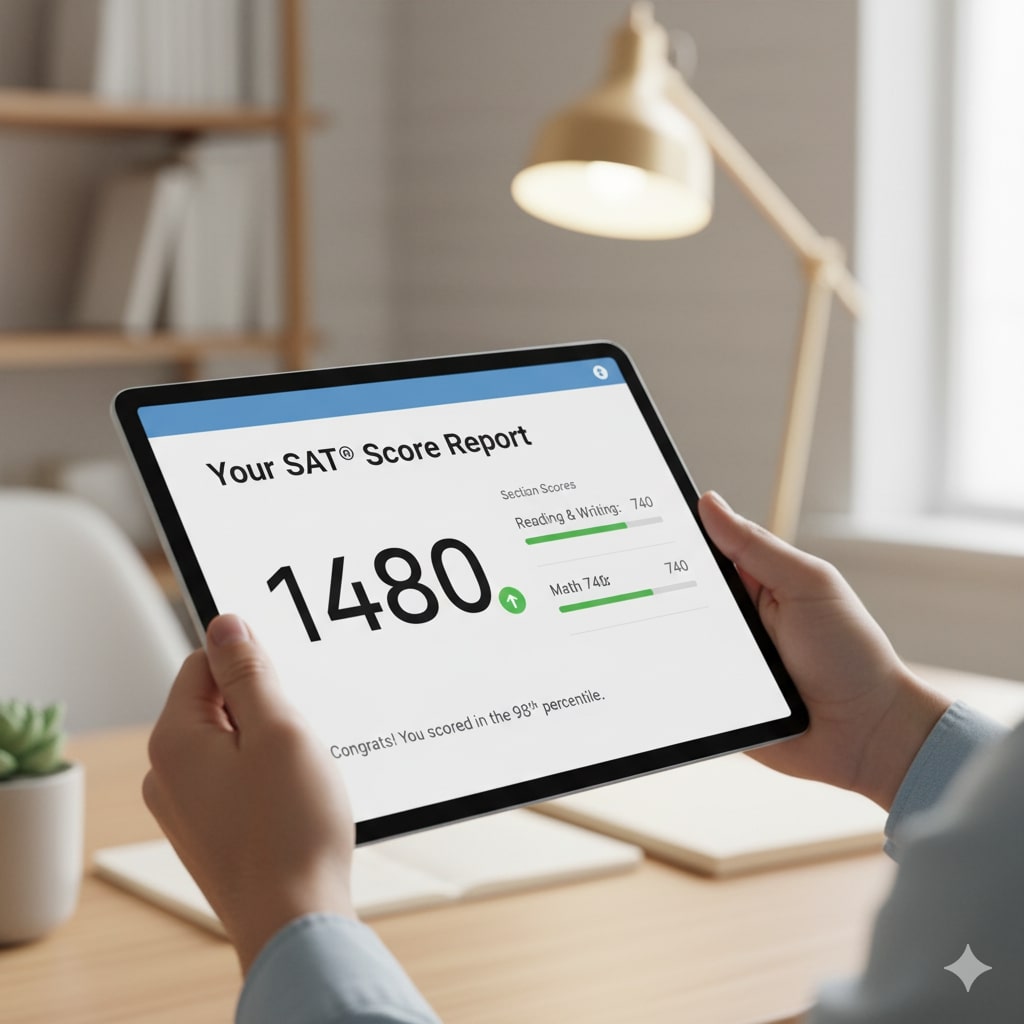Why scores on the SAT feel confusing — and why they don’t have to be
If you’ve ever stared at an SAT score report and wondered how the jumble of numbers translates into college admissions decisions, you’re not alone. One of the most mystifying things about the SAT is the way different kinds of scores — raw scores, scaled scores, and percentiles — all tell different parts of the same story. Understanding how these pieces fit together gives you an edge: you’ll be able to interpret practice tests smarter, set realistic goals, and develop a study plan that actually moves the needle.
Quick roadmap: what you’ll learn in this guide
- What a raw score is and why it matters.
- How raw scores become scaled scores and why scaling exists.
- What percentile ranks mean and how colleges use them.
- Practical examples and a sample conversion table to make it concrete.
- How to use these insights to improve your study strategy and test-day approach.
Raw score: the simplest number that starts everything
The raw score is the count of questions you answered correctly on a section or the whole test. Think of it as the “what actually happened” number — the honest tally of correct responses on test day. There’s no penalty for guessing on the current Digital SAT, so your raw score is simply the number of correct answers you have.
Why raw scores are important
Raw scores are the starting point for everything. They reflect your performance on that specific test form and are used by test designers to determine your section performance before other adjustments are made. When you take practice tests, tracking raw scores helps you see whether your underlying knowledge and skills are improving.
Raw score example
Imagine a Reading & Writing section with 54 questions. If you answer 38 correctly, your raw score for that section is 38. Same idea for Math: if there are 44 questions and you get 30 right, raw score is 30.
Scaled score: the adjusted number that’s fair across different test forms
Scaled scores translate raw scores into the familiar 200–800 section scale and the combined 400–1600 total score. Why does this matter? Test forms vary slightly in difficulty from one test administration to another. Scaled scores account for those differences so your score is comparable even if one test happened to be a touch harder.
How scaling works — in plain English
The SAT’s scoring process takes your raw score and converts it using a pre-determined conversion table created for that specific test form. That conversion reflects question difficulty, question quality, and the distribution of responses across test takers. The goal is fairness: two students who show the same level of mastery should receive the same scaled score even if they took different versions of the test.
Two important things to remember about scaled scores
- Scaled scores allow comparisons across different test dates and forms.
- Scaled scores are what colleges see and typically use in admissions decisions.
Percentiles: where you stand among other test takers
Percentile rank answers a different question: it tells you how your performance compares to other students. If your score is in the 75th percentile, you performed better than 75% of the reference group. Percentiles are relative; they depend on the group used for comparison (e.g., all recent test-takers, all U.S. students, or a specific grade level).
Why percentiles matter
Admissions officers often look at percentiles to quickly understand a candidate’s standing. Percentiles help contextualize a raw or scaled score: a 1200 might mean something different at one point in time than another depending on the performance distribution, but the percentile explains the relative achievement.
Putting it together: raw → scaled → percentile
Here’s the typical flow:
- Raw score: Count correct answers on a test form.
- Scaled score: Convert the raw score using the test form’s conversion table to get a 200–800 section score and 400–1600 total score.
- Percentile: Compare that scaled score to the distribution of scaled scores among a reference group to find your percentile rank.
Sample conversion table (illustrative)
The official conversion tables are specific to each test form and are not publicly identical across all dates, but the table below shows a realistic-looking example of how raw scores might convert to scaled scores. Use it to understand relationships — not as an exact rule for a given test administration.
| Raw Score (Section) | Scaled Score (200–800) | Estimated Percentile |
|---|---|---|
| 10 | 220 | 5th |
| 20 | 340 | 20th |
| 30 | 520 | 50th |
| 36 | 620 | 75th |
| 43 | 760 | 95th |
Note: This table is only illustrative. You’ll see slightly different raw-to-scaled conversions depending on the specific Digital SAT administration.
Concrete worked example: make it real
Suppose your practice test raw scores are:
- Reading & Writing: raw 38 out of 54
- Math: raw 32 out of 44
Using the test-specific conversion tables for that practice test, these raw scores might become (illustrative):
- Reading & Writing scaled: 650
- Math scaled: 620
Total scaled score: 650 + 620 = 1270. That combined score might place you near the 85th percentile, meaning you scored better than roughly 85% of the reference group.
Common misconceptions students have
- “I need to get every question right to hit a high percentile.” Not true. Small raw-score increases can produce significant jumps in scaled scores, especially around the middle of the scale.
- “Percentiles are fixed forever.” They aren’t. Percentiles are recalculated based on who takes the test and how they perform.
- “Scaled scores are arbitrary.” They’re carefully calculated to allow fair comparisons across test forms and administrations.
How to use raw scores on practice tests to make smarter study decisions
Raw scores are especially helpful when you’re tracking progress from one practice test to the next. Here’s how to get the most from them:
- Track raw scores by content domain (e.g., algebra, data analysis, evidence-based reading). That shows where answer knowledge improves independent of scaling quirks.
- Watch for patterns: if raw scores stay flat in one domain, change your study strategy for that domain rather than just increasing practice volume.
- Use raw-to-scaled patterns from practice tests to set micro-goals. For instance, “If I go from raw 30 to 34 on Math, I typically gain ~30 scaled points; so I’ll focus on those four question types that I missed.”

Example study action plan from raw-score insights
- Week 1: Diagnose — take a full practice test, record raw scores by domain.
- Week 2–4: Focused skill blocks — pick two weak domains and do targeted lessons and mixed practice.
- Week 5: Take another practice test. If raw scores improved domain-by-domain, the scaling will likely reflect that in your scaled score.
How colleges read your scores: scaled scores and percentiles in context
Admissions teams typically look at scaled scores, sometimes in conjunction with percentiles, school context, coursework rigor, essays, and extracurriculars. A strong scaled score tells a college you have the academic skills they want; percentiles help them see how you stack up against other applicants. Neither measure operates in isolation — but both matter.
Test day and score-reporting practical tips
- Don’t obsess over a single practice test. Look for trends in raw scores across multiple tests.
- On test day, answer every question — guessing is free on the Digital SAT and can raise your raw score.
- Use percentile information to set realistic, motivating goals. If you’re aiming for the top 10% at a particular college, check recent admitted-student stats for target score ranges when possible.
Using tools, tutoring, and data to accelerate progress
Targeted help can compress months of solo practice into weeks. Personalized tutoring — one-on-one guidance that diagnoses your strengths, builds a tailored study plan, and gives you real-time feedback — is especially effective. When tutors combine human insight with data on your raw-score trends and scaled-score trajectory, you can focus on the high-impact changes that improve your percentile fastest. That’s why many students choose expert tutors who can translate practice results into actionable plans. Sparkl’s personalized tutoring, for example, offers 1-on-1 guidance, tailored study plans, expert tutors, and AI-driven insights to make practice tests more productive and accelerate growth where it matters most.
How to set realistic score targets using percentiles
First, pick a target college or group of colleges and understand their typical admitted ranges. If you want to aim for the 75th percentile among applicants to your chosen group, identify the scaled score that corresponds to that percentile and work backward to a raw-score target on practice tests. Break the goal into monthly raw-score improvements and prioritize content areas that yield the largest scaled-point gains.
A few practical examples of small changes that yield big gains
- Timing strategies: eliminating careless errors by practicing pacing can convert missed questions into raw-score gains quickly.
- Question-type drills: mastering a specific error-prone question type (e.g., data interpretation) often raises raw scores across several practice tests.
- Smart guessing: learning how to eliminate wrong choices increases your chance of a correct guess and raises raw scores without extra study time.
How to interpret score reports after your Digital SAT
Your score report will show section scaled scores, total score, and percentiles. Use it to:
- Identify content domains where percentiles are lower than your overall percentile.
- Check whether improvements in raw scores are translating into meaningful scaled-score gains.
- Decide whether to retake the test based on how close you are to your target percentile and how much time you have to prepare.
When to retake the SAT — a decision framework
Consider retaking if:
- Your scaled score is below the percentile you need for competitive admission at target colleges.
- There is a clear plan to improve raw scores (targeted practice, tutoring, or an adjusted study schedule).
- You have enough time before deadlines to meaningfully raise your score.
Conversely, if you need many small raw-score gains across many domains and deadlines are close, focus on alternatives like strengthening other parts of your application.
Final checklist: turning understanding into action
- Track raw scores by domain on every practice test.
- Compare several practice tests to notice trends rather than reacting to a single result.
- Translate raw-score improvements into expected scaled-score gains using practice-test conversion tables.
- Use percentiles to set motivating, realistic targets linked to your college list.
- Consider one-on-one tutoring or a data-driven tutoring program if you need focused acceleration — personalized coaching often gives the clarity and accountability that turns potential into progress.
Closing thoughts — scores are tools, not verdicts
Raw scores, scaled scores, and percentiles are simply different lenses through which you can view and improve your performance. Raw scores tell you what happened on a given test form. Scaled scores let colleges compare results fairly across test forms. Percentiles show how you stand relative to other test takers. Use each number for what it’s best at: diagnosis, comparison, and context. Armed with this understanding, you can study more strategically, measure progress more honestly, and make better decisions about practice, tutoring, and test-day choices.
Remember: steady, focused improvements in raw scores compound into scaled-score gains and better percentiles. If you’d like a tailored plan that maps your raw-score trends to a clear study calendar and gives you the one-on-one help to get there, consider integrating personalized tutoring into your plan. With the right guidance and consistent practice, the numbers on your next score report will start to tell a very encouraging story.



















No Comments
Leave a comment Cancel